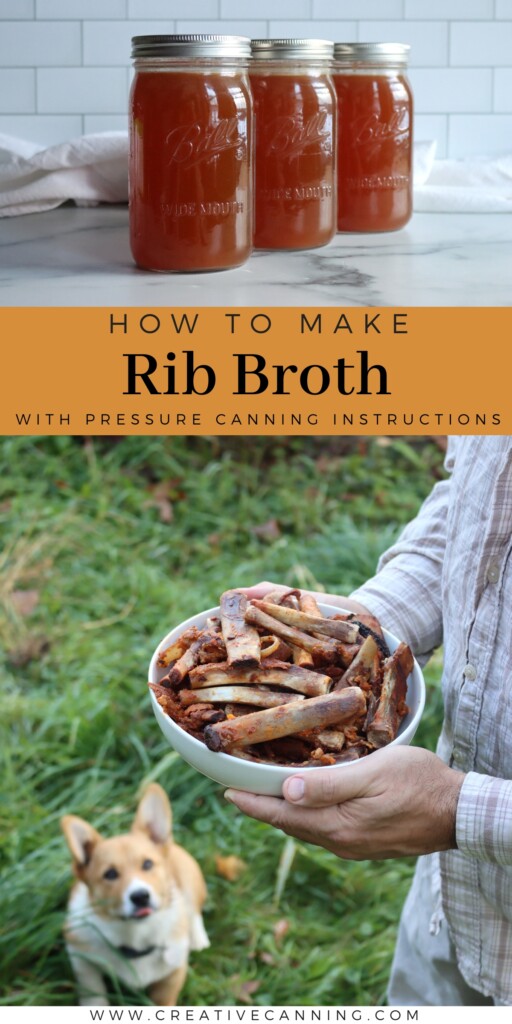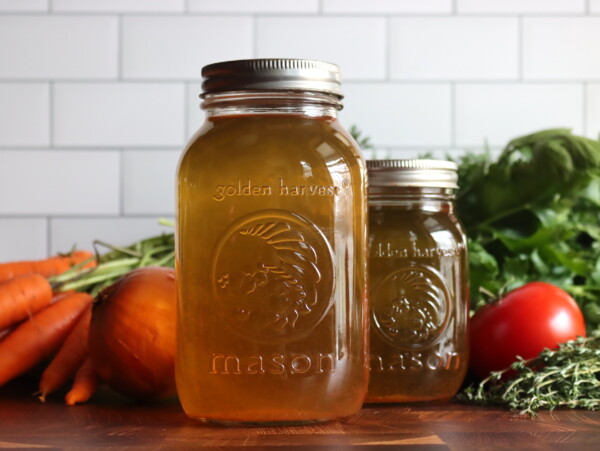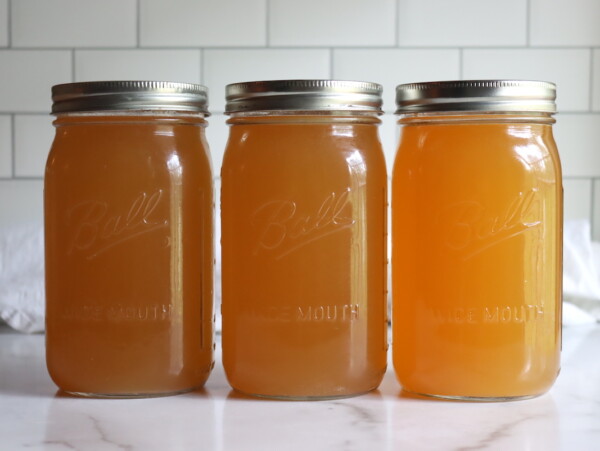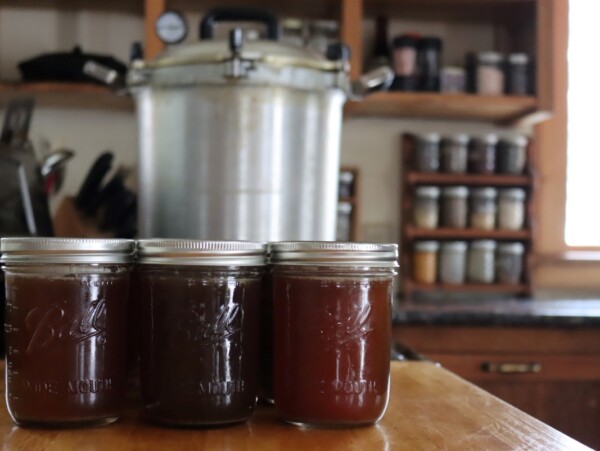This post may contain affiliate links. Please see our disclosure policy.
Rib Broth is a rich, flavorful base for soups, sauces and stews. Made with either beef ribs or pork ribs, it’s a great way to get every last bit of use out of your grocery spending.
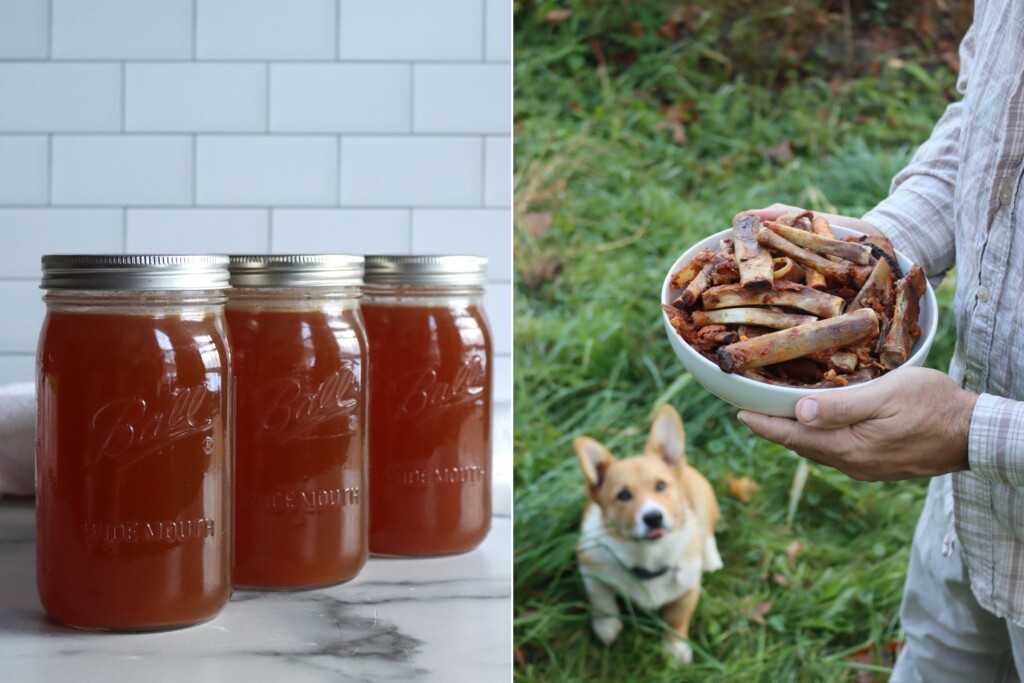
Table of Contents
If you’ve ever enjoyed a hearty plate of ribs, you know just how rich and satisfying the flavors can be. But did you know you can take those leftover bones and turn them into a stock that will elevate your cooking even further?
Whether you’re working with leftover bones from a backyard barbecue, the remnants of a slow-braised beef short rib dish, or fresh rib bones from your butcher, making rib stock is a great way to maximize the flavor of those bones.
After you make the rib broth, you can still give the leftover bones to the bestest of boys in your life. Ours is a Corgi named Pancake.

Rib Bone Quantities for Broth
The amount of bones you’ll need depends on the type of ribs you’re using:
- Pork ribs: A full rack typically contains around 13 bones and the bones weigh about 1 to 1 ½ pounds per rack. This varies slightly depending on whether you’re using baby back ribs, St. Louis-style ribs, or country ribs.
- Beef ribs: A rack of beef ribs generally has between 8 and 13 ribs, depending on how the butcher cuts it. Beef ribs are typically 30 to 50% bone by weight, and a rack weighs around 4 to 6 pounds, so you’re looking at roughly 2 to 3 pounds of bones per rack.
These quantities will affect the final yield of your rib stock, but as a general guideline, for every quart of finished stock, you’ll need approximately 1 pound of rib bones.
We tend to dry rub our ribs with a mixture of salt, garlic and smoked paprika. Whatever’s leftover on the bones gives great flavor and color to the stock too.
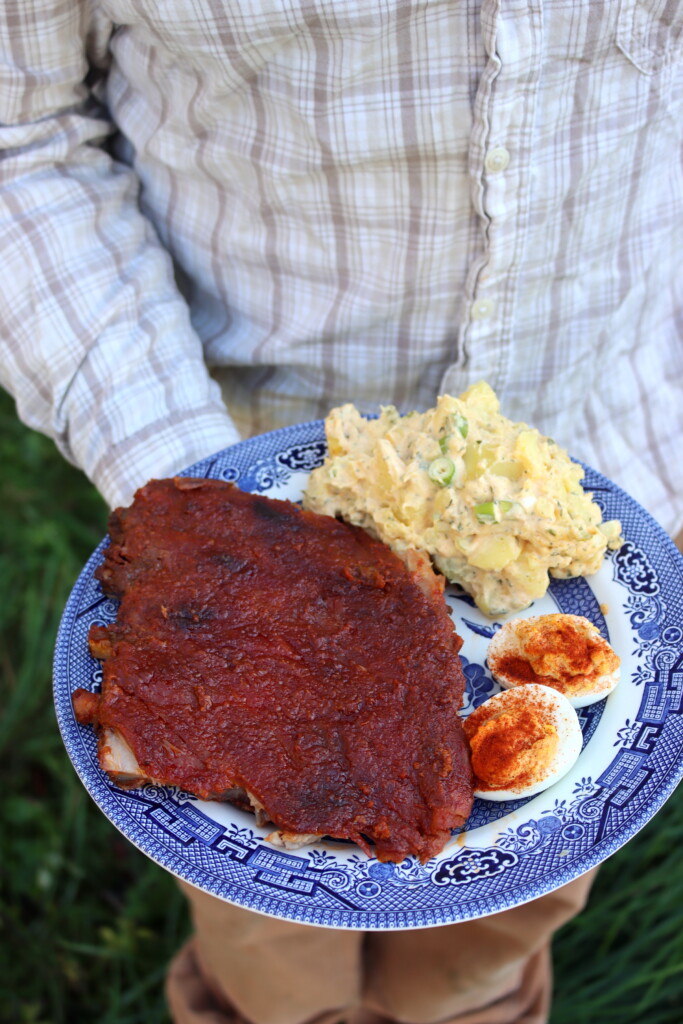
Ingredients for Rib Broth
To make a single quart of flavorful rib stock, you will need:
- 1 pound bones (either beef or pork, or a combination)
- 1 celery rib, chopped
- 1 small carrot (or half a large carrot), chopped
- 1 small onion (or half a large onion), peeled and chopped
- 1 bay leaf
- 5 whole peppercorns
- ⅛ to ¼ teaspoon salt, adjust to taste
- 1 ½ to 2 quarts water
Keep in mind, some of the water will evaporate during cooking, so you can always add more as the stock simmers down, or you can cook it longer to concentrate the flavor.
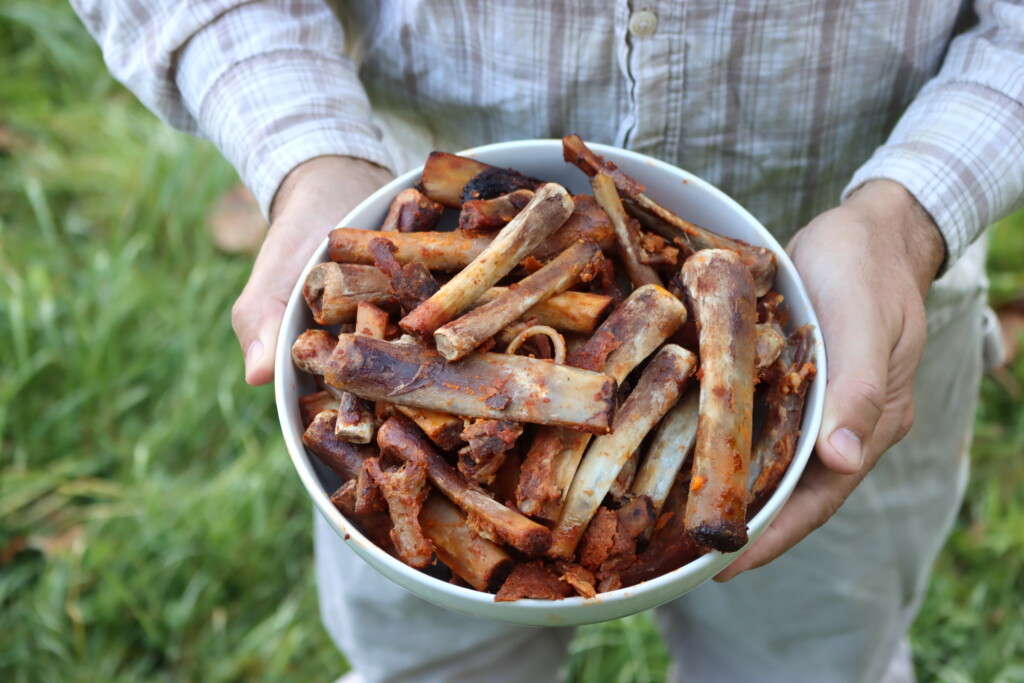
I’ve increased the recipe to make 4 quarts (or one gallon) per batch, as we rarely have just one pound of rib bones on hand. If you’re BBQing, more often than not, you’re making a “git ‘er done” quantity of ribs.
To make a four quart batch for canning, you’ll need:
- 4 pounds bones (either beef or pork, or a combination)
- 4 celery rib, chopped
- 4 small carrot (or two large carrots), peeled and chopped
- 4 small onion (or two large onions), peeled and chopped
- 4 bay leaves
- 10 to 20 whole peppercorns
- 1/2 to 1 teaspoon salt, adjust to taste
- 1 ½ to 2 gallons water
These quantities are approximate, and you can use slightly more or less depending on what you have on hand. I have found that it’s worth your time to peel your carrots for stock, as it gives much better flavor.
How to Make Rib Broth
If you’re working with raw rib bones, roasting them first will deepen the flavor of your stock. Place the bones on a baking sheet and roast in a 400°F oven for 30 to 45 minutes, or until they are nicely browned (but not burned). This step brings out the Maillard reaction, which adds a rich, caramelized flavor to the stock.
If you’re using cooked or leftover bones, there’s no need to roast them — you can proceed straight to the simmering stage.
Place the roasted or leftover bones in a large pot. Add the chopped celery, carrot, onion, bay leaf, peppercorns, and salt. Pour in about 1 ½ to 2 quarts of water, just enough to cover the bones and vegetables.
Bring the mixture to a boil over medium-high heat, then reduce the heat to a simmer. Allow the stock to cook uncovered for about 4 to 6 hours. Skim any foam or impurities from the surface as it cooks.
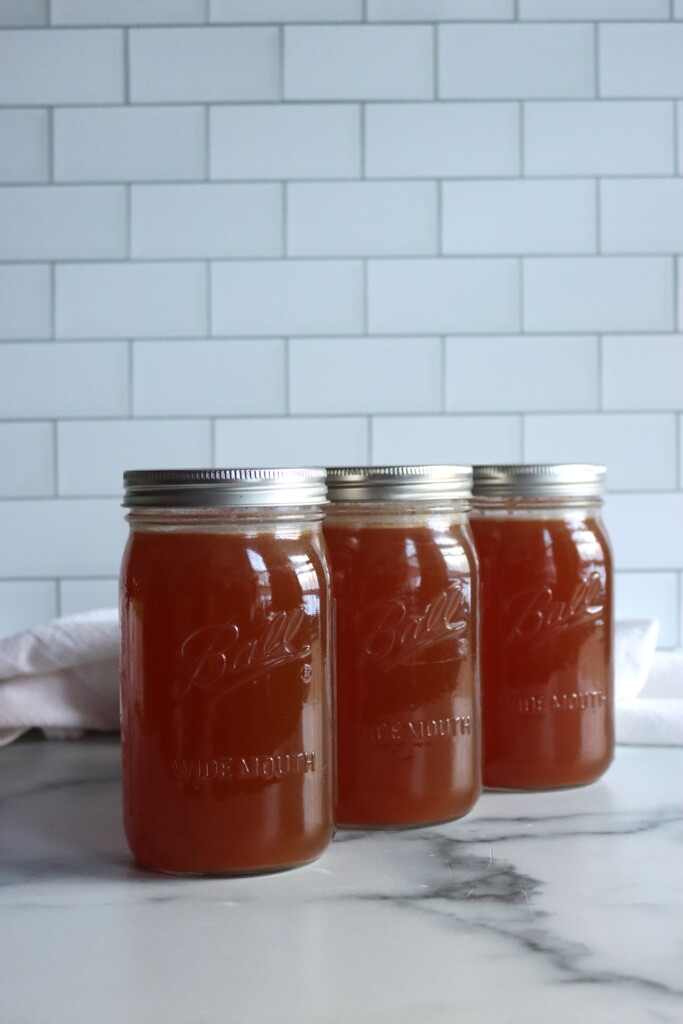
Throughout the simmering process, check the water level. If it gets too low, add more water to keep the bones mostly submerged. The longer the stock simmers, the richer the flavor will become.
Once the stock has simmered for several hours, strain it through a fine-mesh sieve or cheesecloth to remove the bones and vegetables. You should be left with a clear, flavorful stock.
If you prefer a more concentrated stock, you can simmer it further to reduce the volume. Conversely, if it’s too concentrated, you can add a bit of water to reach your desired flavor.
Now you have a beautiful rib stock ready to be used in soups, sauces, gravies, or any dish that calls for a savory, meaty base.
You can freeze it for later use, use it immediately, or pressure can it to store on your pantry shelf.
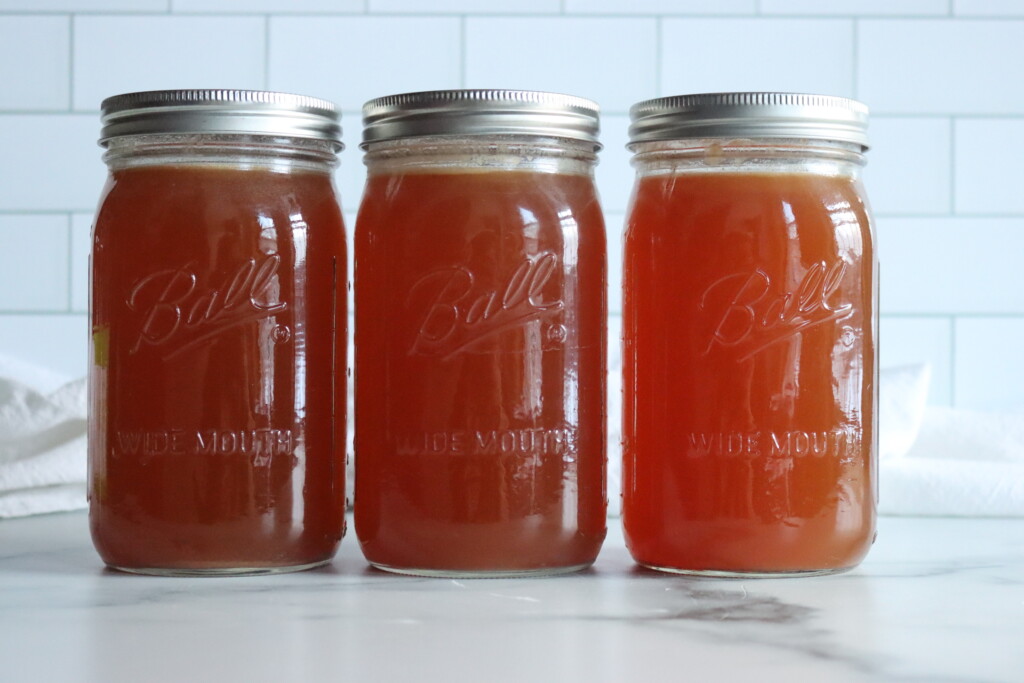
Pressure Canning Rib Broth
Making rib stock in large batches? Pressure canning is a fantastic way to preserve it for later use. Follow these steps to safely can your rib stock:
Prepare your pressure canner by adding a few inches of water and getting it pre-heated.
Make sure your canning jars and lids are clean and sterilized. You can do this by running them through a hot cycle in your dishwasher or boiling them in a large pot.
Pour the hot, strained stock into the sterilized jars, leaving 1 inch of headspace at the top. Be sure to wipe the rim of the jars with a clean cloth to ensure a good seal.
Place the lids on the jars and screw on the rings until they are fingertip-tight. Place the jars in your pressure canner. For pints, process for 20 minutes, and for quarts, process for 25 minutes, adjusting for altitude.
Altitude Adjustments
Pressure remains the same, but processing pressure increases with elevation:
Dial Gauge Canners
- 0–2,000 ft: 11 lbs
- 2,001–4,000 ft: 12 lbs
- 4,001–6,000 ft: 13 lbs
- 6,001–8,000 ft: 14 lbs
Weighted Gauge Canners
- Above 1,000 ft: 15 lbs
- 0–1,000 ft: 10 lbs
Once the processing time is up, allow the canner to cool to zero pounds pressure and carefully remove the jars and allow them to cool completely.
Check the seals: the lids should not flex when pressed in the center. Store sealed jars in a cool, dark place for up to a year. If any jars didn’t seal, refrigerate and use within a week.
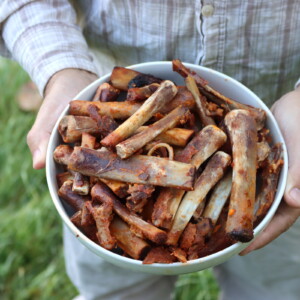
Rib Broth
Equipment
- Stock Pot
Ingredients
- 4 lbs bones, either beef or pork, or a combination
- 4 medium celery rib, chopped
- 4 small carrot, or two large carrots, peeled and chopped
- 4 small onions, or two large onions, peeled and chopped
- 4 whole bay leaves
- 10 to 20 whole peppercorns
- 1/2 to 1 tsp salt, adjust to taste
- 1 ½ to 2 gallons water
Instructions
- Roast bones at 400°F for 30-45 minutes (if raw).
- Add bones, vegetables, bay leaf, peppercorns, and salt to a large pot.
- Cover with 1 ½ to 2 quarts water. Bring to a boil, then reduce heat to simmer.
- Simmer for 4-6 hours, skimming occasionally.
- Strain stock through a fine-mesh sieve. Use immediately, or can using a pressure canner for long-term storage.
- If canning, prepare a canner, jars and rings at this point. Process pints for 20 minutes, quarts for 25 minutes (adjust for altitude, see notes).
Notes
Ingredients per Quart
To make a single quart of flavorful rib stock, you will need:- 1 pound bones (either beef or pork, or a combination)
- 1 celery rib, chopped
- 1 small carrot (or half a large carrot), chopped
- 1 small onion (or half a large onion), peeled and chopped
- 1 bay leaf
- 5 whole peppercorns
- ⅛ to ¼ teaspoon salt, adjust to taste
- 1 ½ to 2 quarts water
Altitude Adjustments
Pressure remains the same, but processing pressure increases with elevation: Dial Gauge Canners-
- 0–2,000 ft: 11 lbs
-
- 2,001–4,000 ft: 12 lbs
-
- 4,001–6,000 ft: 13 lbs
-
- 6,001–8,000 ft: 14 lbs
-
- Above 1,000 ft: 15 lbs
-
- 0–1,000 ft: 10 lbs
Nutrition
Nutrition information is automatically calculated, so should only be used as an approximation.
